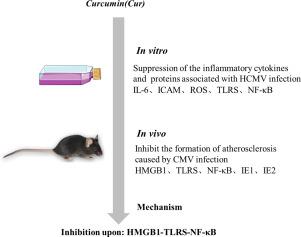Our official English website, www.x-mol.net, welcomes your
feedback! (Note: you will need to create a separate account there.)
Curcumin inhibits the formation of atherosclerosis in ApoE−/− mice by suppressing cytomegalovirus activity in endothelial cells
Life Sciences ( IF 5.2 ) Pub Date : 2020-07-02 , DOI: 10.1016/j.lfs.2020.117658 Ya-Li Lv 1 , Yangjie Jia 1 , Zirui Wan 1 , Zhuo-Ling An 1 , Song Yang 1 , Fei-Fei Han 1 , Li-Li Gong 1 , Ling-Ling Xuan 1 , Lu-Lu Ren 1 , Wen Zhang 1 , He Liu 1 , Li-Hong Liu 1
Life Sciences ( IF 5.2 ) Pub Date : 2020-07-02 , DOI: 10.1016/j.lfs.2020.117658 Ya-Li Lv 1 , Yangjie Jia 1 , Zirui Wan 1 , Zhuo-Ling An 1 , Song Yang 1 , Fei-Fei Han 1 , Li-Li Gong 1 , Ling-Ling Xuan 1 , Lu-Lu Ren 1 , Wen Zhang 1 , He Liu 1 , Li-Hong Liu 1
Affiliation

|
Curcumin (Cur) is a hydrophobic polyphenol compound derived from the rhizome of the herb . Cur has a wide spectrum of biological and pharmacological activities. It has been shown that human cytomegalovirus (HCMV) infection was an important risk factor for atherosclerosis (AS) and Cur exhibited an outstanding anti-HCMV effect. However, anti-AS effects of Cur remain unclear when HCMV infected endothelial cells. This study will investigate the anti-AS activities and mechanism of Cur,when HCMV infected in vivo and in vitro. Cur (0.5, 1, and 2 μM) was used to explore the anti-AS activities and mechanism after HCMV infected endothelial cells in vitro. mice were fed a high fat and cholesterol diet (HD) and given 4000,000 copies/mouse MCMV infection by intraperitoneal and treated with ganciclovir (5 mg/kg/d), Cur (25, 15 mg/kg/d) for 10 weeks in vivo. As our results showed that Cur inhibited CMV replication and proliferation, reduced the intracellular ROS overproduction, decreased the release of inflammatory cytokines, down-regulated the level of HMGB1-TLRS-NF-κB signaling pathway-related proteins in vitro experiments. Cur reduced the serum levels of LDL-C, TC and TG, significantly decreased the formation of atherosclerotic plaque in the aorta, reduced the lipid deposition in liver and inflammatory damage in heart, lung and kidney in vivo experiments. This study showed that Cur prevent AS progression by inhibiting CMV activity and CMV-induced HMGB1-TLRS-NF-κB signaling pathway.
中文翻译:

姜黄素通过抑制内皮细胞中巨细胞病毒活性来抑制 ApoE−/− 小鼠动脉粥样硬化的形成
姜黄素 (Cur) 是一种源自草药根茎的疏水性多酚化合物。 Cur 具有广泛的生物和药理活性。研究表明,人巨细胞病毒(HCMV)感染是动脉粥样硬化(AS)的重要危险因素,而Cur表现出出色的抗HCMV作用。然而,当 HCMV 感染内皮细胞时,Cur 的抗 AS 作用仍不清楚。本研究将探讨Cur在体内外感染HCMV时的抗AS活性及其机制。使用Cur(0.5、1和2μM)体外探讨HCMV感染内皮细胞后的抗AS活性和机制。给小鼠喂食高脂肪和胆固醇饮食 (HD),并通过腹腔注射 4000,000 拷贝/小鼠 MCMV 感染,并用更昔洛韦 (5 mg/kg/d)、Cur (25、15 mg/kg/d) 治疗 10 次。体内周数。体外实验结果表明,Cur抑制CMV复制和增殖,减少细胞内ROS过量产生,减少炎症细胞因子的释放,下调HMGB1-TLRS-NF-κB信号通路相关蛋白的水平。在体内实验中,Cur可降低血清LDL-C、TC和TG水平,显着减少主动脉粥样硬化斑块的形成,减少肝脏中的脂质沉积以及心、肺和肾的炎症损伤。这项研究表明,Cur 通过抑制 CMV 活性和 CMV 诱导的 HMGB1-TLRS-NF-κB 信号通路来预防 AS 进展。
更新日期:2020-07-02
中文翻译:

姜黄素通过抑制内皮细胞中巨细胞病毒活性来抑制 ApoE−/− 小鼠动脉粥样硬化的形成
姜黄素 (Cur) 是一种源自草药根茎的疏水性多酚化合物。 Cur 具有广泛的生物和药理活性。研究表明,人巨细胞病毒(HCMV)感染是动脉粥样硬化(AS)的重要危险因素,而Cur表现出出色的抗HCMV作用。然而,当 HCMV 感染内皮细胞时,Cur 的抗 AS 作用仍不清楚。本研究将探讨Cur在体内外感染HCMV时的抗AS活性及其机制。使用Cur(0.5、1和2μM)体外探讨HCMV感染内皮细胞后的抗AS活性和机制。给小鼠喂食高脂肪和胆固醇饮食 (HD),并通过腹腔注射 4000,000 拷贝/小鼠 MCMV 感染,并用更昔洛韦 (5 mg/kg/d)、Cur (25、15 mg/kg/d) 治疗 10 次。体内周数。体外实验结果表明,Cur抑制CMV复制和增殖,减少细胞内ROS过量产生,减少炎症细胞因子的释放,下调HMGB1-TLRS-NF-κB信号通路相关蛋白的水平。在体内实验中,Cur可降低血清LDL-C、TC和TG水平,显着减少主动脉粥样硬化斑块的形成,减少肝脏中的脂质沉积以及心、肺和肾的炎症损伤。这项研究表明,Cur 通过抑制 CMV 活性和 CMV 诱导的 HMGB1-TLRS-NF-κB 信号通路来预防 AS 进展。











































 京公网安备 11010802027423号
京公网安备 11010802027423号